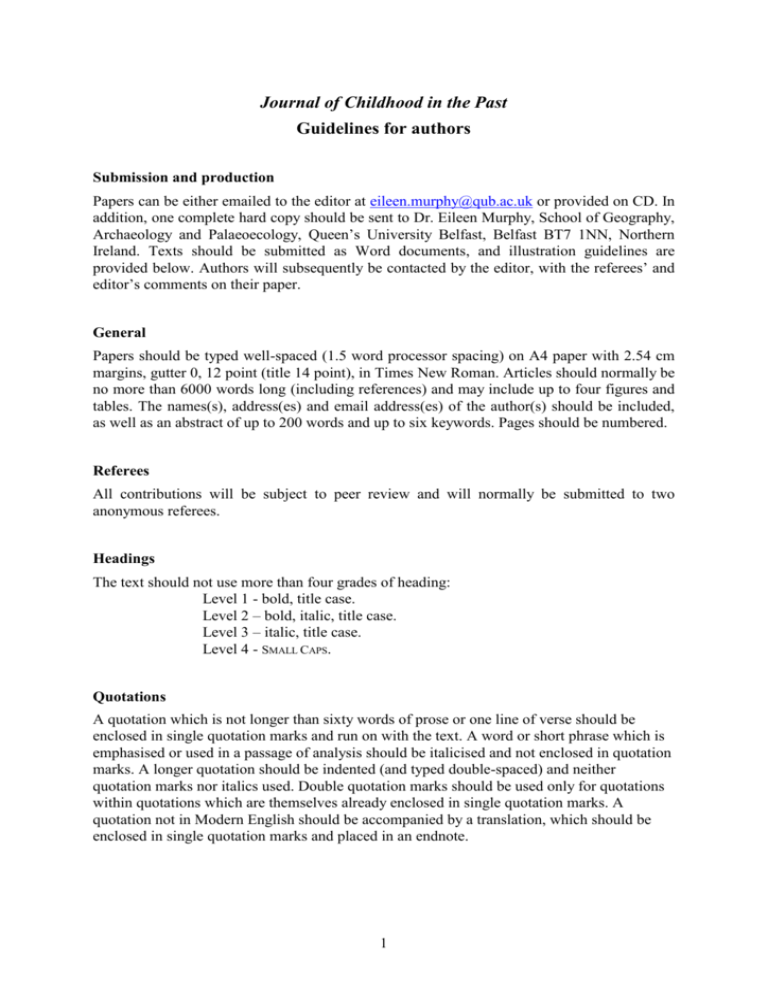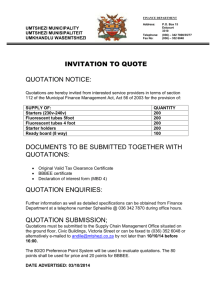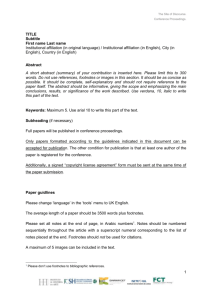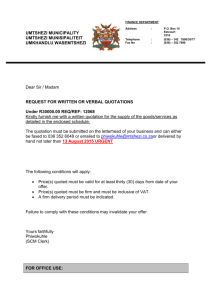
Journal of Childhood in the Past
Guidelines for authors
Submission and production
Papers can be either emailed to the editor at eileen.murphy@qub.ac.uk or provided on CD. In
addition, one complete hard copy should be sent to Dr. Eileen Murphy, School of Geography,
Archaeology and Palaeoecology, Queen’s University Belfast, Belfast BT7 1NN, Northern
Ireland. Texts should be submitted as Word documents, and illustration guidelines are
provided below. Authors will subsequently be contacted by the editor, with the referees’ and
editor’s comments on their paper.
General
Papers should be typed well-spaced (1.5 word processor spacing) on A4 paper with 2.54 cm
margins, gutter 0, 12 point (title 14 point), in Times New Roman. Articles should normally be
no more than 6000 words long (including references) and may include up to four figures and
tables. The names(s), address(es) and email address(es) of the author(s) should be included,
as well as an abstract of up to 200 words and up to six keywords. Pages should be numbered.
Referees
All contributions will be subject to peer review and will normally be submitted to two
anonymous referees.
Headings
The text should not use more than four grades of heading:
Level 1 - bold, title case.
Level 2 – bold, italic, title case.
Level 3 – italic, title case.
Level 4 - SMALL CAPS.
Quotations
A quotation which is not longer than sixty words of prose or one line of verse should be
enclosed in single quotation marks and run on with the text. A word or short phrase which is
emphasised or used in a passage of analysis should be italicised and not enclosed in quotation
marks. A longer quotation should be indented (and typed double-spaced) and neither
quotation marks nor italics used. Double quotation marks should be used only for quotations
within quotations which are themselves already enclosed in single quotation marks. A
quotation not in Modern English should be accompanied by a translation, which should be
enclosed in single quotation marks and placed in an endnote.
1
Numbers
Numbers should be in words if less than 100 and if not within a specific reference,
measurement, date, list or table or part of extensive statistical data, e.g.: the tenth century; a
late-tenth-century manuscript; twenty-six occasions; sixty-four per cent; but 64% (if part of
extensive data), and 40 x 95 mm. Otherwise they should be in figures. Numbers in a series
should be in accordance with these examples:
(a) 50-4 (not 50-54), 891-6 (not 891-896 or 891-96), 300-4
(b) 410-12 and 413-15 (not 410-2 and 413-5)
(c) 732-43 (not 732-743)
(d) 465 and 840 (not 465, 840)
(e) 465, 840 and 940 (not 465, 840, 940 or 465, 840, and 940)
In references to manuscripts or lines of poetry which specify the side of a leaf or the part of a
line, the principles implicit in (a)-(c) have to be waived: e.g. 44r-45v (not 44r-5v) and 104a104b (not 104a-4b).
Dimensions should normally be given in metric units. Please note the British Standard units
are the metre and the millimetre. Where measurements have been taken to the nearest
millimetre, measurements should still be rendered as two decimal places of a metre, e.g. 0.35
m instead of 350 mm. In cases where measurements have been taken in Imperial units or
where the use of Imperial dimensions greatly facilitates comparisons with previous literature,
they may be used in brackets immediately following, e.g. 4 ft 6½ in by 1 ft 9 in (1.38 x 0.53
m). In quotations from other authors using only Imperial units, metric equivalents should be
inserted in square brackets, e.g. [1.38 x 0.53 m]. Please note the spacing and punctuation in
these examples.
Punctuation
In general, British punctuation should be used, e.g. commas outside quotations marks, single
rather than double quotation marks (except for quotations within quotations) and no comma
before ‘and’ in a series, or before ‘etc.’ Hyphenation should be kept to the minimum; for
guidance, see the Shorter Oxford English Dictionary. No stop should be used after an
abbreviation which includes the last letter of the word (e.g. Dr or St); but a stop should be
used after the -s of a plural if it would be used after the corresponding singular e.g.
ch., chs.; fol., fols.; vol., vols.; col., cols.
A superscript number, indicating the place in the main text to which an endnote refers, should
follow adjacent punctuation and be enclosed in square brackets, e.g. ‘the one who performed
evil magic against me’,² (not ‘the one who performed evil magic against me’², or ‘the one
who performed evil magic against me²’,).
Parenthetical or emphatic dashes should be typed as spaced en-rules (a single dash), and not
as single or double hyphens, or as em-rules (spaced or unspaced).
2
e.g. These objects were perforated so that they could be worn in a necklace or – in the case of
bigger objects – hung on the wall.
Not
These objects were perforated so that they could be worn in a necklace or - in the case of
bigger objects - hung on the wall.
These objects were perforated so that they could be worn in a necklace or -- in the case of
bigger objects -- hung on the wall.
These objects were perforated so that they could be worn in a necklace or—in the case of
bigger objects—hung on the wall.
Lower case
Lower case should be used for the initial letter of a word such as ‘church’, ‘king’, ‘bishop’, or
‘psalter’, unless the word is part of a title as in, e.g., the Harley Psalter or King Alfred. An
initial capital is preferred for ‘Bible’, ‘Continent’ and ‘Insular’.
Dates
Dates should be standardised on the models 18 April 2003, 18 April and April 2003. For an
approximate date, the correct form is c. 840 (not ca. 840). BC is used in the usual way (e.g.
2000 BC), as is AD (e.g. AD 545). If using an estimated date c. should be italicised e.g. c.
2000 BC.
When using radiocarbon dates the raw date (BP) should be provided, followed by the date’s
laboratory identification number and calibrated date range in brackets.
E.g. The upper-most level dated to 12,160±180 BP (I-4963; 13,500-11,700 cal. BC).
It should be stated whether the calibrated range is at one sigma or two sigma level.
Abbreviations and styles
et al.
cf.
e.g.
i.e.
and (not &)
in prep.
pers. comm.
No fullstops after abbreviations such as m (=metre), cm (=centimetre) and other abbreviations
of measurements.
3
All spelling should be in UK English rather than US English.
Illustrations
Text and illustrations will be printed in black and white. All illustrations should be provided
in computerised format. Please print them out and check that they display what they are
supposed to show when printed in black and white before submitting them. All figures and
tables need to be saved as separate files and not embedded in the text. Each illustration file
should be clearly labelled as Fig. 1, Table 1 etc.
The following image formats are acceptable:
TIFF: with a resolution of 600 dpi
Excel: Tints and patterns in Excel charts should be noticeably different. Tints need to be in
increments of at least 25%. Do not use complicated patterns. Vertical, horizontal and diagonal
lines are best, and check that they are easily recognisable in the legend. DO NOT place the
chart on a grey background.
Word: High resolution line artwork and tables. We CANNOT accept embedded photos.
Adobe Illustrator: Convert to black and white. If using versions earlier than 9 please make
sure that all fonts are embedded or included on the disk, or save them as a PDF.
Photoshop: All formats are OK.
Do not use separate numbers for line drawings and photos. These should all be treated as
figures and numbered in one sequence. Please avoid sub-numbering such as Fig. 7a, Fig. 7b –
call them Fig. 7 and Fig. 8. Please ensure that there is a numbered reference to each figure and
table in the text and that these are in numerical order.
A list of captions for figures and tables should be supplied as a separate file and not included
as part of an image.
Please cite the copyright for illustrations, where necessary, in the captions. It is the author’s
responsibility to ensure that all copyright permissions have been gained.
Abbreviations
A list of any abbreviations used should be given before the bibliography, listed under the
separate heading ‘Abbreviations’.
References
All works cited in the main body of the text (including tables etc.) should be listed in full in
the bibliography in alphabetical order by authors’ surname. Titles of articles should be in
plain text, titles of books should be in italic as should periodical titles.
4
Books should normally be cited in their most recent edition and both the publishing group
and place of publication as required.
Every significant word in a title in English should begin with a capital; lower case is retained
for small words such as articles, pronouns, prepositions and conjunctions etc. (e.g. the, their,
in honour of, presented to), unless, of course, the word in question is the first in the title. All
journal papers should be in lower case with the exception of the first word, placenames etc.
The abbreviation(s) ‘ed.’, or ‘ed. and trans.’, should be included in the bibliographic entry
alone and must be used strictly in accordance with the formula appearing on the title-page of
the book in question.
In the text, references should be indicated by the author’s name, the year of publication
followed by page numbers, as follows: Percival (1921, 178) or (Hall and Kenward 1980, 23;
Paap 1984, 32). Where three or more authors are involved, use Davies et al. in the text but all
of the authors’ names in the list of references. Footnotes and endnotes should be avoided.
Examples of references are provided below:
Book
Cobbett, W. 1979. Cottage Economy (reprint of 1850 edition). Oxford: Oxford University
Press.
Crawford, S. 1999. Childhood in Anglo-Saxon England. Stroud: Sutton.
Cunningham, H. 2005. Children and Childhood in Western Society Since 1500 (second
edition). London: Pearson Longman.
Duby, G. 1968. Rural Economy and Country Life in the Medieval West (translated from 1962
French edition by C. Postan). London: Edward Arnold.
Huskinson, J. 1996: Roman Children’s Sarcophagi: Their Decoration and its Social
Significance (Oxford Monographs on Classical Archaeology). Oxford: Clarendon Press.
Scott, E. 1999: The Archaeology of Infancy and Infant Death (BAR International Series 819).
Oxford: Archaeopress.
Sofaer-Derevenski, J. 2000 (ed.): Children and Material Culture. London: Routledge.
5
Journal Article
Donnelly, S., Donnelly, C. and Murphy, E. 1999. The forgotten dead: the cilliní and disused
burial grounds of Ballintoy, County Antrim. Ulster Journal of Archaeology 58, 109-13.
Smith P. and Kahila, G. 1992. Identification of infanticide in archaeological sites: a case
study from the Late Roman-Early Byzantine periods at Ashkelon, Israel. Journal of
Archaeological Science 19, 667-75.
Paper in Edited Volume
Jalland, P. 1999. Victorian death and its decline: 1850-1918, pp. 230-55 in Jupp, P. C. and
Gitting, C. (eds.), Death in England: An Illustrated History. Manchester: Manchester
University Press.
Book Series
Beckett, J. F. 2005. Selective burial in Irish megalithic tombs; burial practice, age, sex, and
representation in the Neolithic, pp. 31-9 in Zakrzewski, S. R. and Clegg, M. (eds.),
Proceedings of the Fifth Annual Conference of the British Association for Biological
Anthropology and Osteoarchaeology (BAR International Series 1383). Oxford:
Archaeopress.
Fibiger, L. 2005. Minor ailments, furious fights and deadly diseases: investigating life in
Johnstown, County Meath, AD 400-1700, pp. 99-110 in O’Sullivan, J. and Stanley, M. (eds.),
Recent Archaeological Discoveries on National Road Schemes 2004 (Archaeology and the
National Roads Authority Monograph Series No. 2). Dublin: National Roads Authority.
Thesis
Amorosi, T. 1996. Icelandic Zooarchaeology: New Data applied to Issues of Historical
Ecology. Unpublished Ph.D. thesis, City University of New York.
Unpublished Report
Buckland, P. 1995. St George’s School, Margaret Street, Walmgate, York. The insect remains
(appendix), in Foster, P. and Symonds, J., An archaeological evaluation at St George’s School,
Margaret Street, Walmgate, York. Unpublished ARCUS report 208, University of Sheffield.
Hall, A. R., Kenward, H. K. and Robertson, A. 1993c. Investigation of medieval and postmedieval plant and invertebrate remains from Area II of the excavations in The Bedern (northeast), York (YAT/Yorkshire Museum sitecode 1976-81.14 II). Unpublished Ancient Monuments
Laboratory Report 58/93.
6
Author(s) + Other Contributor(s)
Brochier, J. E., Villa, P. and Giacomarra, M. with an appendix by Tagliacozza, A. 1992.
Shepherds and sediments: geo-ethnoarchaeology of pastoral sites. Journal of Anthropological
Archaeology 11, 47-102.
References to manuscripts
It is desirable to give manuscript shelfmarks whenever possible: thus reference should be
made not simply to the Harley Psalter, but to the Harley Psalter (London, British Library, MS
Harley 603). It is also desirable to specify whenever possible the origin and date (and
provenance too, if so wished) of a given manuscript, always in the following form:
London, British Library, Royal 15. C. VII (Old Minster, Winchester, s. x/xi);
Oxford, Bodleian Library, Rawlinson C. 697 (NE France, s. ix2; later provenance Bury St
Edmunds).
If reference is to the recto or verso of a manuscript leaf, 'fol.' should be omitted and 'r' or 'v'
should be specified (e.g. 87r, 87v, 26r-27v (not 26r-7v) or 35r-43v). If reference is to a leaf
(or leaves) as a whole 'fol(s).' should be used (e.g. fol. 86, fols. 86-93 or fols. 86 and 88).
References to particular lines of a leaf, or to leaves written in double columns, should be
made thus: 74r12, 32ra or 45vb12 or 126va39-126vb11.
Standard examples for first references to manuscripts are:
Cambridge, Corpus Christi College 422, pp. 27-586 (Winchester, s. ximed; provenance
Sherborne), p. 283, line 7 - p. 284, line 10;
Cambridge, Trinity College B. 11. 2 (St Augustine's, Canterbury, s. xmed), 62r;
Oxford, Bodleian Library, Hatton 20 (Worcester, s. ixex), 32r16-33v21;
London, British Library, Add. 37517 (Canterbury, s. x2), fols. 13-15;
London, British Library, Cotton Tiberius B. i (Abingdon, s. xi1-xi2), fol. 3;
London, British Library, Royal 1. B. VII (?Northumbria, s. viii1; provenance Christ Church,
Canterbury), 15v;
Brussels, Bibliothèque Royale, 1650 (Abingdon, s. xiin);
Coburg, Landesbibliothek, 1 (?Metz, s. ix), 168r.
(Note (a) that names of places should be given in standard English forms; (b) that there is a
space between the components of a shelfmark, and after the s. abbreviation in a date; and (c)
that if the word ‘Library’, or its foreign equivalent, is present, a comma is used before the
shelfmark; if ‘Library’ or its foreign equivalent is not present, no comma is used in that
position.)
7
Book reviews
Childhood in the Past offers reviews of recent published works from a range of sources on
all aspects of the study of childhood in the past. We welcome books for review throughout the
year from publishers. The Reviews Editor –Simon Mays– also directly requests books from
publishers, and will respond to members’ suggestions for books or other material for review.
He may be contacted at simon.mays@english-heritage.org.uk
Reviews are generally short (400 words) or medium length (800-1000), but longer reviews or
review articles may also be requested (for example, when two or more related publications
are considered). Normally the Reviews Editor seeks reviewers; however, we welcome offers
to review publications. The Reviews Editor will request that reviews be submitted by
email/cd/disk within three months of the acceptance of the commission. Reviews will follow
the Journal house style: as with Journal articles, submissions which do not follow house style
will be returned for correction.
The Reviews Editor does not normally send out proofs. Publishers receive copies of the
published reviews, but not the individual reviewers.
8









